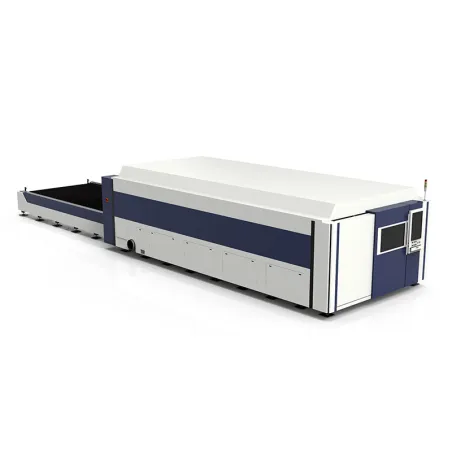A laser cutting machine utilizes a laser beam as a cutting tool, extensively used for cutting various materials, including metals and non-metals. The 3000W laser cutting machine is a commonly available device known for its high cutting precision and efficiency. This article covers the cutting capabilities, applications, working principle, operational precautions, and maintenance of the 3000W laser cutting machine.
Cutting Capabilities of 3000W Laser Cutting Machines
1. Cutting Thickness: The cutting thickness varies based on laser power, cutting speed, and material type:
- Carbon Steel: 0.5mm-20mm
- Stainless Steel: 0.5mm-12mm
- Aluminum Alloy: 0.5mm-8mm
- Copper and Brass: 0.5mm-6mm
- Note: Actual cutting results may vary based on equipment performance and operator skills.
2. Cutting Precision: The machine typically achieves a cutting precision of ±0.05mm due to its high-precision control system and non-contact cutting characteristics, ensuring smooth and precise cut surfaces.
3. Cutting Speed: Varies depending on material type and thickness:
- Carbon Steel: 10-30 meters per minute
- Stainless Steel: 5-20 meters per minute
- Aluminum Alloy: 10-25 meters per minute
- Copper and Brass: 5-15 meters per minute

Applications of 3000W Laser Cutting Machines
The machine is widely used in metal processing, machinery manufacturing, automotive, aerospace, electronics, medical devices, and construction decoration industries. Specific materials it can cut include:
- Metal Materials: Carbon steel, stainless steel
- Light Metals: Aluminum alloy, magnesium alloy
- Non-Ferrous Metals: Copper, brass, tin, lead
- Non-Metal Materials: Wood, plastic, rubber, leather
- Brittle Materials: Glass, ceramics, stone
Additional resources:
Working Principle of 3000W Laser Cutting Machines
The laser cutting machine operates by directing a high-power laser beam onto the material surface, causing it to melt, vaporize, or burn, achieving cutting through several steps:
1. Laser generator produces a high-power laser beam.
2. The beam is focused by an optical system to create a high-energy density laser beam.
3. The laser beam irradiates the material surface, causing rapid melting, vaporization, or burning.
4. The cutting head moves along a predetermined path, enabling continuous cutting.
5. Auxiliary gases (e.g., nitrogen, oxygen) blow away slag and gases produced during cutting, ensuring a clean cut surface.
Operational Precautions
1. Operators must undergo professional training and be familiar with operational procedures and safety requirements.
2. Wear protective gear such as safety glasses and gloves to prevent laser radiation and flying debris injuries.
3. Regularly inspect the equipment's performance and precision to ensure it is in good working condition.
4. Adhere to the specified cutting parameters for materials to avoid poor cutting results or equipment damage.
5. Monitor the cutting process and stop immediately if anomalies occur.
6. Clean the cut surface promptly after cutting to remove residual slag and oxides, ensuring cleanliness and precision.
Maintenance of 3000W Laser Cutting Machines
1. Regularly check the performance of critical components like the laser generator, optical system, and cutting head.
2. Clean optical elements such as mirrors and lenses regularly to prevent dust and dirt from affecting laser quality.
3. Regularly check and replace auxiliary gases to ensure an adequate supply during cutting.
4. Maintain mechanical parts such as the machine bed and guide rails to ensure stability and precision.
5. Conduct comprehensive equipment inspections and maintenance periodically, addressing any issues promptly to prevent failures.
In summary, the 3000W laser cutting equipment offers high cutting capability and precision, making it suitable for cutting a wide range of materials in various industries.
Previous: Key Factors for Choosing the Right Inverter Welder
Next: None
Related Articles
Comments
Please Join Us to post.
0